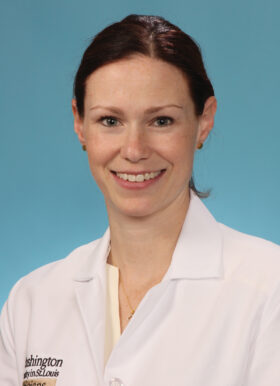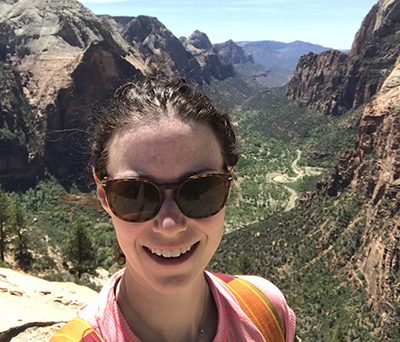Jennifer Strahle, MD

Jennifer Strahle, MD, is a neurosurgeon who specializes in pediatric neurosurgery including spinal deformity, scoliosis, brain and spine tumors, spina bifida, Moya Moya, Chiari malformations, spine trauma and hydrocephalus.
Dr. Strahle sees patients at:
- St. Louis Children’s Hospital, 1 Children’s Place, Suite 4S20, St. Louis, MO 63110
Please call 314-454-2810 to make an appointment.
What happened in the course of your schooling to influence you to choose pediatric neurosurgery?
My exposure to neuroscience began as early as high school – when I learned about the nervous system. That interest continued during my undergraduate studies at Bates College in Maine where I majored and performed research in neuroscience.
After my undergraduate studies, I worked in a lab studying Alzheimer’s disease. It was at that point that I realized my focus was going to be on medicine and treating patients, but that I wanted to continue doing research in the field of neuroscience as well.
Realizing the extensive training required for neurosurgery, I also considered other specialties during medical school. I ultimately chose neurosurgery and I’m very glad that I did.
How did you come to pediatric neurosurgery?
I enjoy that it is a diverse field within neurosurgery — allowing me to treat conditions of both the brain and spine. I also enjoy the relationships I can form with children and their families. Pediatric neurosurgery gives me the opportunity to have a lasting impact on children for years to come.

What brought you to Washington University?
Washington University is a special place. I was drawn here by the strength of its pediatric neurosurgery department, as well as the excellence of its research enterprise. It is nationally renowned in both clinical care and research.
As a physician, my goals are to provide excellent clinical care, but also to advance our understanding of neurological disease – my research interests are in hydrocephalus and the pathophysiology of scoliosis. I came here for pediatric neurosurgery fellowship and remained as faculty.
My practice allows me to treat patients in the clinic and the operating room, while also studying the mechanisms of hydrocephalus and brain injury after neonatal intraventricular hemorrhage.
I also study how conditions of the brain and spine interact to cause spinal deformity, such as scoliosis and kyphosis.
What is neonatal intraventricular hemorrhage?
Neonatal intraventricular hemorrhage usually occurs in very preterm infants – those that are born as early as 25-26 weeks’ gestation. It results from hemorrhage in the germinal matrix extending into the ventricles – the fluid-filled spaces inside the brain.
This bleeding into the ventricles can alter the balance of this fluid causing a condition called hydrocephalus. The neurosurgeon’s role has historically been to manage this increased pressure with an operation. But there is a lot more going on than just the development of hydrocephalus, as the brain is still undergoing tremendous development during this time.
My goal is to better understand how bleeding in the ventricles causes hydrocephalus in some infants who develop intraventricular hemorrhage and ultimately prevent it from developing at all, sparing these children a lifetime of surgeries and other complications.
Which aspect of your practice is most interesting?
That’s a difficult question for me to answer – I am fortunate that my practice is varied, and I enjoy all aspects of it. I specifically enjoy being able to take what I see in my patients on a day-to-day basis, translate it back to the lab and then generate questions to allow me to improve the treatment and care of my patients.
What new developments in your field are you most excited about?
I am most excited about potential advances in the treatment of neonatal post hemorrhagic hydrocephalus. We are learning more and more about how it occurs and potentially how to prevent its long-term effects in our neonates.
I’m hopeful that within the next decade – but definitely before the end of my career – we will be able to introduce new treatments to prevent hydrocephalus, potentially eliminating the need for surgical intervention.
I also focus on diseases of the spine and how they result in scoliosis. One of the treatments for scoliosis is spinal fusion which involves placement of hardware into each vertebral segment. New technology, such as robot-assisted placement of instrumentation, may ultimately improve our care for patients with scoliosis who need a spinal fusion.
Where are you from?
I grew up in New Jersey, and spent most of my time on the East Coast – until moving to the Midwest for medical school, residency, fellowship training and now medical practice. I’ve lived in Minnesota, Michigan and Missouri – and I have come to appreciate everything the Midwest has to offer.
For someone visiting New Jersey, what is a “must see”?
Despite the critiques in the media regarding coastal New Jersey, there are beautiful beaches, scenic hiking trails and outdoor areas.
Is there a particular award or achievement that is most gratifying?
The achievement that is most gratifying is that I was able to start my family during residency. My husband and I have two young girls and I was fortunate to have encouragement and support from my mentors to do so.
I take great joy in watching my daughters grow up.
What is the best advice you’ve received?
I’ve received a lot of advice over the years, but one piece of advice that stuck with me is to “Surround yourself with the types of people you aspire to be.”
We spend so much time at work, it is important to be in an environment with mentors and colleagues that you respect and look up to. These individuals provide an example of excellence that will allow you to strive to do more.
If you weren’t a doctor, what would you like to be doing?
I enjoy the outdoors, so if I wasn’t a physician, I would likely work outdoors – probably as a kayak guide. I am looking forward to exploring the many rivers in Missouri.